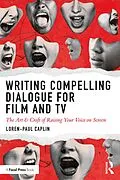Writing Compelling Dialogue for Film and TV is a practical guide that provides you, the screenwriter, with a clear set of exercises, tools, and methods to raise your ability to hear and discern conversation at a more complex level, in turn allowing you to create better, more nuanced, complex and compelling dialogue.
The process of understanding dialogue writing begins with increasing writers' awareness of what they hear. This book provides writers with an assortment of dialogue and language tools, techniques, and exercises and teaches them how to perceive and understand the function, intent and thematic/psychological elements that dialogue can convey about character, tone, and story. Text, subtext, voice, conflict, exposition, rhythm and style are among the many aspects covered. This book reminds us of the sheer joy of great dialogue and will change and enhance the way writers hear, listen to, and write dialogue, and along the way aid the writers' confidence in their own voice allowing them to become more proficient writers of dialogue.
Written by veteran screenwriter, playwright, and screenwriting professor Loren-Paul Caplin, Writing Compelling Dialogue is an invaluable writing tool for any aspiring screenwriter who wants to improve their ability to write dialogue for film and television, as well as students, professionals, and educators.
Autorentext
Loren-Paul Caplin has written feature films and TV scripts for studios and independents, including Paramount, Universal, Sony, and Fox Searchlight. He teaches and has taught screenwriting at Columbia University, NYU/Tisch Department of Dramatic Writing, The New School (where he co-authored the Screenwriting Certificate Curriculum) and Hofstra University. He also wrote/directed the feature, The Lucky Ones (Tribeca Film Festival, 2003) and short film The History of the World in 8 Minutes (New Directors/New Films Festival, MoMA) as well as several plays, and has done commentary for Criterion Collection and is a screenwriting consultant.
Klappentext
Writing Compelling Dialogue for Film and TV is a practical guide that provides you, the screenwriter, with a clear set of exercises, tools, and methods to raise your ability to hear and discern conversation at a more complex level, in turn allowing you to create better, more nuanced, complex and compelling dialogue.
The process of understanding dialogue writing begins with increasing writers' awareness of what they hear. This book provides writers with an assortment of dialogue and language tools, techniques, and exercises and teaches them how to perceive and understand the function, intent and thematic/psychological elements that dialogue can convey about character, tone, and story. Text, subtext, voice, conflict, exposition, rhythm and style are among the many aspects covered. This book reminds us of the sheer joy of great dialogue and will change and enhance the way writers hear, listen to, and write dialogue, and along the way aid the writers' confidence in their own voice allowing them to become more proficient writers of dialogue.
Written by veteran screenwriter, playwright, and screenwriting professor Loren-Paul Caplin, Writing Compelling Dialogue is an invaluable writing tool for any aspiring screenwriter who wants to improve their ability to write dialogue for film and television, as well as students, professionals, and educators.
Inhalt
- Acknowledgements
- Fade In: Introduction
- PART ONE: On Dialogue
- Chapter One: Understanding Dialogue
- Intro: Understanding Dialogue
- Function & Purpose
- Defining Better Dialogue
- Tone
- Text & Subtext
- Voice
- Conflict,
- Exposition,
- Style
- Chapter Two: Illuminating Character Through Dialogue
- Introduction: Understanding Character
- Character Arc
- Outer and Inner Goals
- Wants, needs, drives, passions
- Externalizing the Internal
- Putting It All Together
- Chapter Three: Types of Dialogue
- Introduction: Types of Dialogue
- Basic Dialogue
- Repartee
- Monologues
- Asides & Soliloquies
- Heightened & Stylised Dialogue
- Realistic/Naturalistic Dialogue
- Chapter Four: Voice-Overs & Narrations
- Introduction: Voice-Overs and Narrations
- So, what is it?
- Structure Markers
- Asides & Soliloquies
- Emotionality
- Literary Dimension
- The Three Basic Types of Voice-Over:
- The Voice of God V.O.
- Looking Back V.O.
- Part of the Narrative V.O.
- When is it appropriate to use voice-overs?
- Chapter Five: Platforms
- Introduction: Platforms
- Theater
- Film
- TV
- Prose Fiction
- Film Dialogue vs. TV Dialogue
- PART TWO: Tool Kits for Improving Your Dialogue
- Chapter Six: Tool Kit - Writing Dialogue
- Introduction: Writing Dialogue
- Starting - What do you do?
- Intention - What do you want?
- Structure, Shape and Pace
- The Do's, Don'ts and Exceptions
- Chapter Seven: Tool Kit - Specificity
- Introduction: Specificity
- Nouns
- Modifiers
- Unique Words
- Technical, Authentic Word,
- Colorful Words
- Colloquial Language and Vernacular
- Chapter Eight: Tool Kit - Writing Singular Characters
- Introduction: Writing Singular Characters
- Finding Character
- Conflict
- Quirks and Unique Logic
- Energy: Passion & Pop Content
- Chapter Nine: Tool Kit - Naturalistic Dialogue, Themes & Exposition Problems
- Introduction: Naturalistic Dialogue, Themes & Exposition Problems
- Naturalistic Dialogue
- Theme Words
- Remedying Exposition
- PART THREE: Exercises: Better Hearing & Voicing Your Characters
- Chapter Ten: Accessing Character & Application
- Introduction: Accessing Character & Application
- Character Complexity
- Character Bios for Dialogue
- Application: What to do
